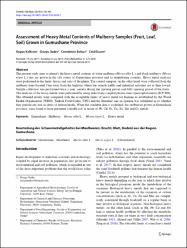Assessment of Heavy Metal Contents of Mulberry Samples (Fruit, Leaf, Soil) Grown in Gumushane Province
Erişim
info:eu-repo/semantics/closedAccessTarih
2019Erişim
info:eu-repo/semantics/closedAccessÜst veri
Tüm öğe kaydını gösterKünye
O. Kalkisim, D. Ozdes, C. Baltaci, C. Duran, “Assessment of Heavy Metal Contents of Mulberry Samples (Fruit, Leaf, Soil) Grown in Gumushane Province”, Erwerbs-Obstbau, 61, 85-96 (2019).Özet
The present study aims to identify the heavy metal contents of white mulberry (Morus albaL.) and black mulberry (Morus nigraL.) that are grown in the city center of Gumushane province and its neighboring counties. Heavy metal analyzes were performed in the fruits, leaves and soils of the plants. The control samples, on the other hand, were collected from the mulberry trees located 3km away from the highway where the vehicle traffic and industrial activities are at their lowest. Sample collection was performed twice ayear, namely during the ripening period and fully ripening period of the fruits.The analyses of the heavy metals were performed by using inductively coupled plasma-mass spectrophotometry (ICP-MS). The obtained results were compared with the acceptable limits of heavy metal for humans as established by the World Health Organization (WHO), Turkish Food Codex (TFC) and the literature and an opinion was submitted as to whether they present any risk in terms of human health. When the available data is evaluated, the mulberries grown in Gumushane province, were found to have presented ahealth risk in terms of Pb, Cd, Ni, Cu, Zn, Mn and Co metals.


















